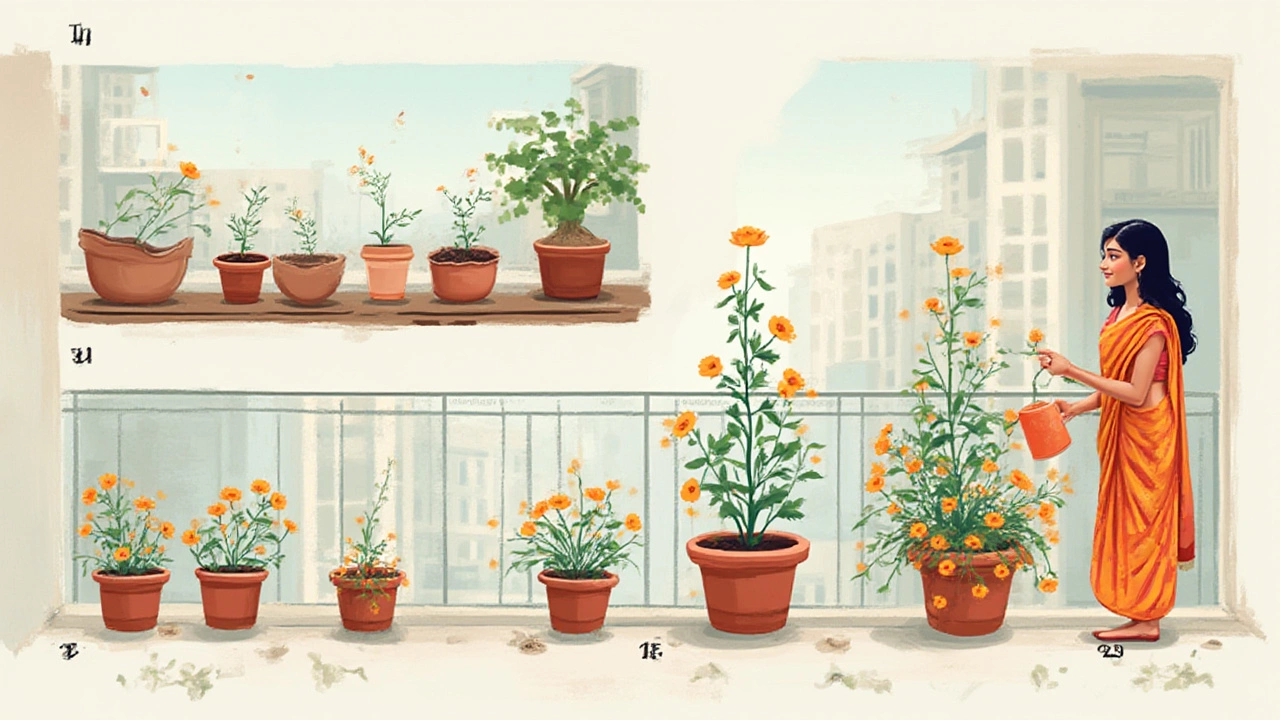Easiest Flowers to Grow: Beginner-Friendly Garden Blooms That Thrive Anywhere

Imagine walking outside, coffee in hand, and finding your garden bursting with color, even if you haven’t lifted a watering can in days. Sounds impossible, right? Yet, for rookie gardeners (or the simply lazy ones), some flowers practically beg to grow with almost zero fuss. You don’t need fancy fertilizers or a PhD in horticulture. But which flower actually deserves the crown for being the easiest to grow? Is there a clear winner, or do a few blooms tie for first place? Grab your gloves—this quest may leave you questioning why you ever settled for plastic plants indoors.
The Undisputed Champion: Why Marigolds Win Every Time
Let’s cut to the chase: if we’re talking about easiest flower to grow, marigolds own the spotlight. Ask any gardener, from grizzled veterans to the neighbor who calls you when their orchid turns brown, and the top answer usually matches: marigold. These golden-orange wonders thrive in almost any soil, forgive a missed watering (or three), and even handle summer heat waves like pros. Toss their seeds on the ground, give them a light rake-in, and they’ll do the rest. Seriously, it’s almost embarrassing how little they demand.
According to the Cornell Cooperative Extension, “Marigolds are perhaps the best first flower for beginning gardeners, as they tolerate wide variations in temperature, soil, and moisture.” Don’t just take their word for it—watch the kids at a local science fair, and there’s a good chance their ‘growing flowers in a cup’ project features a sprightly marigold winning by week two.
Why so simple? Marigold seeds are larger than most, practically shouting "plant me!" when you hold them between your fingers. They don’t need special treatment, indoor starting, or delicate transplanting. Once up, marigolds bloom quickly (some varieties in as little as 50 days), and keep on pumping out color until frost. Deadheading spent blooms encourages more—proof of how responsive these flowers are even to simple care. Put them in containers, edge a vegetable bed, or just go wild along your fence line. Wherever sun shines, marigolds wave their heads.
But it’s not just about looks—marigolds punch above their weight. They naturally repel certain garden pests (think nematodes and whiteflies); some organic growers plant them as living bug shields. Want a garden you barely touch but still stays healthy? Toss in marigolds.
"Planting marigolds is like giving your garden an immune system boost—they’re as tough as they are cheerful." – Dr. Linda Chalker-Scott, Washington State University
Here’s an at-a-glance table showing just how user-friendly marigolds are compared to some other common flowers:
| Flower | Sunlight Needed | Bloom Time | Germination Speed | Heat Tolerance | Pest Resistance |
|---|---|---|---|---|---|
| Marigold | Full Sun | Early Summer–Frost | 5–10 days | High | High |
| Petunia | Full Sun | Late Spring–Frost | 10–14 days | Medium | Low |
| Zinnia | Full Sun | Summer–Frost | 5–7 days | High | Medium |
| Sunflower | Full Sun | Mid Summer–Autumn | 7–10 days | High | Medium |
One last thing: marigolds are nontoxic to pets. Worried about dogs investigating your new flowerbed? Marigolds won’t harm them—unlike lilies or foxglove, which can be downright dangerous. Now, if that doesn’t push this flower toward “no-brainer” status, what does?

Close Contenders: Other Flowers That Refuse to Die
Say you’re not wild about marigold colors or you want something different in every corner. There’s a handful of flowers that nearly match marigolds in sheer effortlessness. Zinnias, nasturtiums, cosmos, and sunflowers are basically nature’s apology for folks who’ve previously killed cacti.
Zinnias are like the marigold’s funky, colorful cousin. Their seeds go straight into the ground when it’s finally warm, no fussing with indoor pots or weird temperature tricks. Sure, they like sun and well-drained soil, but you could plant zinnias next to the driveway and they’d still put on a show. Just watch out for mildew in super-humid spots—planting with plenty of room for airflow keeps them drama-free.
Nasturtiums take low-maintenance to a whole new level. Not only do they sprout easily, but their leaves and flowers are edible. Throw ‘em into salads or use as a spicy, colorful garnish—no other "easy" flower lets you taste test straight from the border. They don’t need rich soil (in fact, if you pamper them, they get floppy and leafy, skipping the best blooms).
Cosmos? You could practically toss cosmos seeds out a car window and come back a month later to see them blooming. These tall, feathery flowers laugh in the face of dry soil and skipped waterings. Pollinators love them, too—think bees and butterflies buzzing around without an ounce of extra work from you. Their only pet peeve: too much fertilizer. Skip it, and you’ll get nonstop color until autumn.
And then there’s the granddaddy of easy flowers: the sunflower. Sure, they take up space (these aren’t houseplants!), but you can count on a few seeds making a summer jungle—even if you have kids who dig them up or squirrels who check in regularly. If you’ve ever dreamed of a selfie with an eight-foot-tall bloom and a wide grin, this is your moment.
Here's a quick breakdown of their quirks, superpowers, and minimum needs:
- Zinnia: Loves heat, best from seed direct-sown, dozens of color choices.
- Nasturtium: Almost weed-like, tastes good, dislikes too-fertile soil, perfect for hanging baskets.
- Cosmos: Thrives on neglect, sky-high stems, pollinator magnet.
- Sunflower: Needs space, giant blooms, great bird food, dramatic backdrop.
If you live somewhere with more shade than sun—look at impatiens or begonias. These guys don’t match marigold in toughness but do bloom all season in less light. Just keep them watered, and you’ll get vivid color where others fail.
Tip: If budget is a concern, look for “annual mixes” at your garden center. These cheap, colorful blends include the above flowers plus a few surprises that are just as easy to manage. Sprinkle, water once, and wait—you’ll basically have a meadow by midsummer. Don’t forget, half the battle is planting the right thing for your environment. Always check your last frost date and match the variety to your climate zone. Even easy flowers have limits if you push them outside their comfort zone.

Real-World Tips: How to Rock Your First Flowers Without Drama
Here’s the deal: the right flower can make you look like a gardening genius, while the wrong one has you sulking at the compost bin. Even with bulletproof picks like marigolds and their friends, a few small moves make all the difference.
Start with the soil. None of these flowers demand gourmet compost, but breaking it up with a shovel (or even just a stick) before planting helps roots spread. For clay soil, sprinkle in a shovel of bagged compost—it’s like loosening tight jeans after dinner. Avoid soggy lawn corners or compacted earth; both can drown or choke roots.
When sowing seeds, less is more. Planting too thick means seedlings fight each other, looking thin and weak. For marigold, zinnia, and cosmos seeds, spread about an inch apart, and thin them to 4-6 inches once they’re two inches high. Nasturtiums should stay even further apart, since their vines spread wide.
Watering? Ignore the urge to hover and soak daily. Go deep once a week—soak the soil until it’s moist several inches down, then let it almost dry. Roots grow deeper, plants stand tough, and you'll dodge most fungal problems. The best test: stick your finger fully in the dirt. If it comes out dry, water. If it’s cool and damp, chill.
Some flowers self-seed, so after the first year, you might find “volunteer” plants popping up where you didn’t expect. Marigolds can do this, especially some older strains. Zinnias and cosmos, too—the gift that keeps on giving, as long as you don’t chop every bloom before it goes to seed.
Deadheading (snipping off spent flowers) sounds laborious, but it’s mindless and oddly satisfying. You’ll trigger more blooms, and the plant will reward you with a regular comeback of fresh petals. No pruners? Fingertips work just fine—pinch just below the fading head.
If pests show up, don’t panic. For most easy flowers, a blast from the hose removes aphids and keeps foliage clean. Neem oil sprays can help with larger infestations, but let your marigolds do their thing—they repel bugs from their neighbors, too.
Planning for next season? Save seeds from the healthiest, best-blooming plants. Let flowers fade and dry on the stem, then pluck and store the seeds in an envelope. Come spring, sprinkle them and repeat the magic. Some gardeners have marigold lines running in their families for generations this way—no flower shop required.
Wondering if it’s truly that easy? Head to local community gardens and observe: most low-maintenance beds are packed with golden marigolds, wild zinnias, and a few sunflowers nodding over the edge. Why reinvent the wheel when these classics just work?
If you want to get fancy after nailing these basics, try mixing varieties. There are chocolate-colored marigolds, zinnias with dahlia-like heads, and sunflowers in shades from buttery yellow to deep wine. Even easy-keepers can be stylish, so let your creativity run wild—without ever risking bare patches in the flower bed again.





